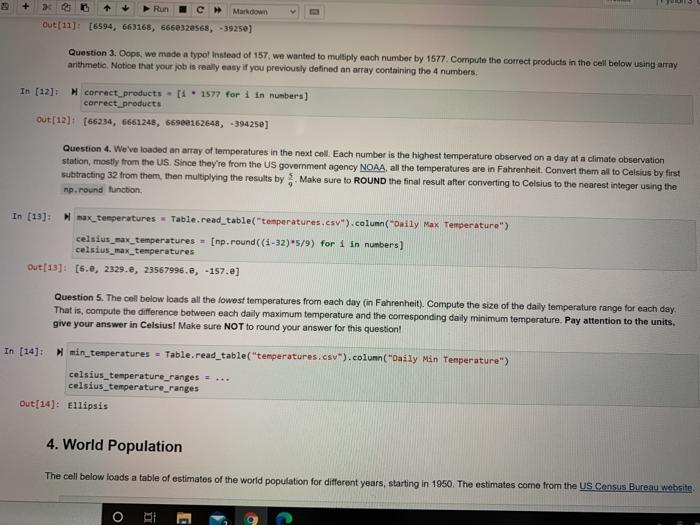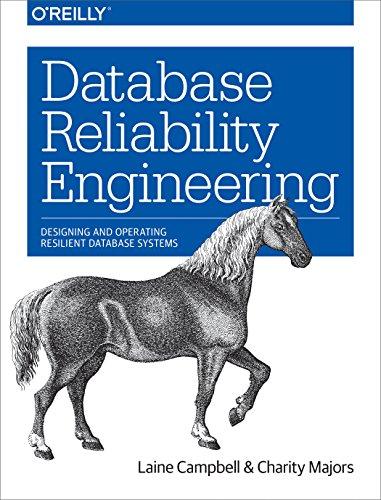these 3 questions please

+ Run C Markdown Out[11]: [6594, 663168, 6660320568, -39250] Question 3. Oops, we made a typol Instead of 157, we wanted to multiply each number by 1577. Compute the correct products in the cell below using array arithmetic Notice that your job is really easy if you previously defined an array containing the 4 numbers In [12]: W correct products (1577 for i in numbers] correct products Out[12]: (66234, 6661245, 66902162648, -394250] Question 4. We've loaded an array of temperatures in the next coll. Each number is the highest temperature observed on a day at a climate observation station, mostly from the US. Since they're from the US government agency NOAA, all the temperatures are in Fahrenheit. Convert them all to Celsius by first subtracting 32 from them, then multiplying the results by Make sure to ROUND the final result after converting to Celsius to the nearest integer using the np. round function In [13]: Nmax_temperatures - Table.read_table("temperatures.csv").column("Daily Max Temperature") celsius_max_temperatures - (np.round((1-32) *5/9) for i in numbers) celsius_max_temperatures Out[13]: [5.2, 2329.8, 23567996.0, -157.0) Question 5. The cell below loads all the lowest temperatures from each day in Fahrenheit). Compute the size of the daily temperature range for each day. That is, compute the difference between each daily maximum temperature and the corresponding daily minimum temperature. Pay attention to the units. give your answer in Celsius! Make sure NOT to round your answer for this question In [14]: min_temperatures - Table.read_table("temperatures.csv").column("Daily Min Tenperature") celsius_temperature_ranges = ... celsius_temperature_ranges Out[14]: Ellipsis 4. World Population The cell below loads a table of estimates of the world population for different years, starting in 1950. The estimates come from the US Census Bureau website + Run C Markdown Out[11]: [6594, 663168, 6660320568, -39250] Question 3. Oops, we made a typol Instead of 157, we wanted to multiply each number by 1577. Compute the correct products in the cell below using array arithmetic Notice that your job is really easy if you previously defined an array containing the 4 numbers In [12]: W correct products (1577 for i in numbers] correct products Out[12]: (66234, 6661245, 66902162648, -394250] Question 4. We've loaded an array of temperatures in the next coll. Each number is the highest temperature observed on a day at a climate observation station, mostly from the US. Since they're from the US government agency NOAA, all the temperatures are in Fahrenheit. Convert them all to Celsius by first subtracting 32 from them, then multiplying the results by Make sure to ROUND the final result after converting to Celsius to the nearest integer using the np. round function In [13]: Nmax_temperatures - Table.read_table("temperatures.csv").column("Daily Max Temperature") celsius_max_temperatures - (np.round((1-32) *5/9) for i in numbers) celsius_max_temperatures Out[13]: [5.2, 2329.8, 23567996.0, -157.0) Question 5. The cell below loads all the lowest temperatures from each day in Fahrenheit). Compute the size of the daily temperature range for each day. That is, compute the difference between each daily maximum temperature and the corresponding daily minimum temperature. Pay attention to the units. give your answer in Celsius! Make sure NOT to round your answer for this question In [14]: min_temperatures - Table.read_table("temperatures.csv").column("Daily Min Tenperature") celsius_temperature_ranges = ... celsius_temperature_ranges Out[14]: Ellipsis 4. World Population The cell below loads a table of estimates of the world population for different years, starting in 1950. The estimates come from the US Census Bureau website









